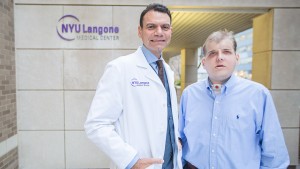This past August, Hardison, now 41, received an entirely new scalp and face. For the first time since 2001, he has ears, a nose, lips, and eyelids, the last was especially crucial because, although he retained his vision on the fire, he was unable to blink or close his eyes for 14 years. His new face was donated by 26-year-old David Rodebaugh, a young BMX biker from Brooklyn, who was pronounced brain dead after being thrown off his bike. The revolutionary face transplant took 26 hours and was performed by plastic surgeon Dr. Eduardo Rodriguez, along with a 150-person medical team.
It involved a team of more than 100 physicians, nurses, and technical and support staff led by Eduardo D. Rodriguez, MD, DDS, the Helen L. Kimmel Professor of Reconstructive Plastic Surgery and chair of the Hansjörg Wyss Department of Plastic Surgery. The team worked in two adjoining operating rooms, in one room the donor’s face was procured (along with other donated organs), and in the other the recipient’s face and scalp burn was removed and the transplant took place.
The recipient, volunteer firefighter Patrick Hardison, 41, of Senatobia, MS, was injured in September 2001.Patrick entered a burning home on a rescue search, when its roof collapsed on him, leaving him with disfiguring burns across his entire face, head, neck, and upper torso. He lost his eyelids, ears, lips, and most of his nose, as well as his hair, including his eyebrows. After enduring more than 70 surgeries in Mississippi and elsewhere, Patrick was still unable to return to a normal life. He was brought to Dr. Rodriguez’s attention by a member of his church and fellow firefighter, who wrote to the doctor describing Patrick’s situation. Dr. Rodriguez, who previously performed a complex face transplant in 2012, and his NYU Langone team transplanted not only the face but also the entire scalp. Patrick’s surgery was pivotal in that the donor’s eyelids and the muscles that control blinking were transplanted a significant milestone and a procedure that had not been previously performed on a seeing patient.
The transplantation of the donor’s eyelids and blinking mechanisms was particularly important to the surgery’s success, as Patrick was in danger of losing his sight and had been unable to perform independent daily tasks, such as driving. Within the final hours of surgery, signs of success were evident. Patrick’s new face, particularly his new lips and ears, were robust with color, indicating circulation had been restored. The hair on his scalp, as well as the beard on his face, began growing back immediately. He was able to use his new eyelids and blink on the third day of recovery, after the swelling began to diminish. He was sitting up in a chair within a week. And now, just three months removed from surgery, swelling has greatly subsided and he is quickly returning to the routines of daily life independently.
With every successful transplant surgery, there is always a donor and donor family that makes the altruistic gifts possible during one of the most difficult times in their lives. In Patrick’s case, his donor was David P. Rodebaugh, 26, an Ohio-born Brooklyn artist and bicycling enthusiast, who tragically died from injuries sustained in an accident. David’s career pursuits took him to New York, where he was advancing his training in cycling mechanics, design, and customization. He also won several cycling competitions, gaining a loyal following of fans and admirers in New York and across the country in the close-knit BMX cycling community. David also was a registered organ donor. LiveOnNY, the organ recovery organization for the greater New York metropolitan area, approached David’s mother and informed her of David’s wishes to be an organ donor, explaining to her the importance of organ donation. They comforted David’s loved ones as they made the decision to donate David’s face, as well as his heart, liver, and kidneys to other recipients, and to research. The implementation of the NYU Langone face transplant program required extensive collaboration with LiveOnNY, which began over a year ago after Patrick was identified to receive the program’s first face transplant. Unlike other situations in which organs can be recovered and transported from distant hospitals, Dr. Rodriguez and his team needed to perform the recovery of David’s face in an operating room adjacent to the OR where Patrick’s transplant would take place. LiveOnNY also coordinated with Dr. Rodriguez and his team and other hospitals and transplant teams to procure David’s other donated organs.
Patrick, like all transplant patients, will need to remain on anti-rejection medication for the rest of his life to prevent transplant rejection. Patrick will also rely on his family and friends particularly his fellow firefighters in Senatobia to support him in his recovery and his transition back to his hometown after he is discharged from the hospital. He will also have regular monthly checkups with Dr. Rodriguez and the face transplant team. An important lesson learned was that with a skilled and experienced leader at the helm, a facial transplantation program can be created and, in Dr. Rodriguez’s case, re-created at a medical facility with the appropriate talent, resources, and multidisciplinary commitment to teamwork.
For more information please visit: www.nyulangone.org

